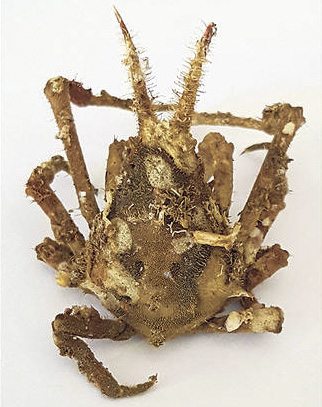Published in the Ocean Watch column, Honolulu Star-Advertiser © Susan Scott
December 30, 2017
Year-end highlights or summaries aren’t my favorite reading material because the articles mostly contain facts about things I already know. Therefore, for this last Ocean Watch of the year, I’ll share some emails sent to me in 2017 that I loved, and answered, but didn’t have room to publish.
In March, reader Greg wrote, “My coworker found an odd crab … and we were wondering if this is an illegal alien that came to Hawaii during the Navy war games. … It’s a small guy … approximately one inch wide.”
 Hawaii is home to at least 20 species of small spider crabs.
Hawaii is home to at least 20 species of small spider crabs.
Pictured is one such Hawaii spider crab.
Courtesy Morris Moribe
Greg put the crab on ice in his freezer in “solidarity confinement.”
No need to worry about an invasion, though. Greg’s photos showed a spider crab native to Hawaii’s waters.
Hawaii hosts at least 20 species of spider crabs, all oddly triangular shaped. The one Greg’s friend found is common near Hawaii’s shorelines where brown seaweeds wash ashore.
But bring a magnifying glass to examine them. The crabs are only a half-inch to 1 inch wide, as well as being remarkably camouflaged.
Also called collector or decorator crabs, spider crabs have hooked hairs on their bodies that snag bits of seaweed, sponges, corals or other tiny animals drifting past. So besides being small, spider crabs can look like anything but a crab.
Claire, a loyal reader in the Seattle area, brought new facts about another marine animal to my attention last spring in a New York Times link (goo.gl/27XbPN) about fang blennies. (Claire is my 94-year-old mother-in-law who keeps me on my toes via her iPhone.)
Fang, or sabertooth, blennies are little Davids to the ocean’s Goliaths. When a predator fish takes a fang blenny in its mouth, the 2- to 4-inch-long blenny uses its two lower front fangs to bite the captor’s mouth. In response to the pain, the predator spits out the rascal unharmed.
Researchers recently learned that some fang blennies go a step further, injecting an opioid-containing venom during a bite. The venom doesn’t get the predator high, but rather drops its blood pressure by 40 percent.
We humans would feel faint and dizzy with such a drastic BP decrease. Although no one knows how it makes the fish feel, it can’t be good. With its head aquiver, the predator spews out the blenny.
Hawaii hosts several fang blennies but none that pack poison.
Ah, once again, I am out of space and have barely scratched the surface of my 2017 emails.
Readers, please know that I appreciate your personal stories, thoughtful questions, links to news items and words of encouragement. When I’m traveling or sailing I can’t always reply, but I read and enjoy all your messages.
Thank you for swimming with me into 2018. Another year, another 52 fish.